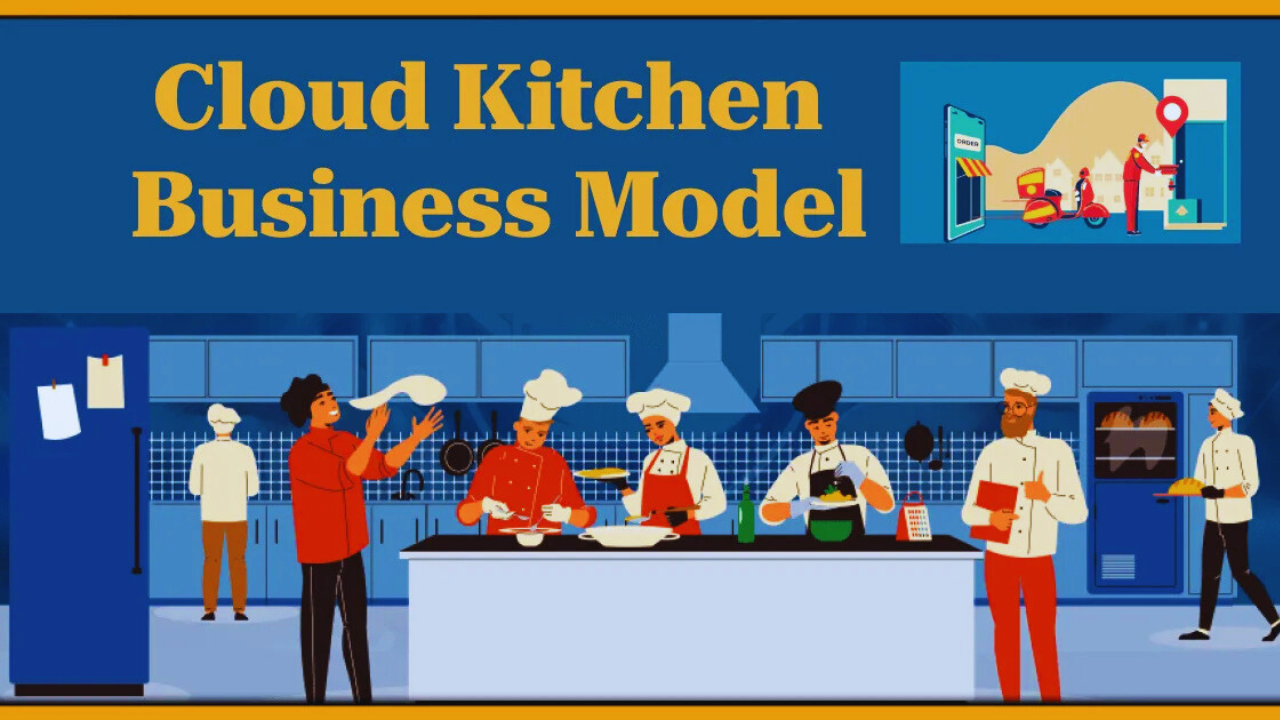The cloud kitchen business model has become a game-changer in the food industry, offering a modern and efficient way to cater to the growing demand for online food delivery services. With the rapid rise of food delivery platforms like UberEats, Zomato, and DoorDash, consumers now prefer the convenience of having their favorite meals delivered to their doorsteps. Traditional restaurant owners are increasingly adopting the cloud kitchen model, which focuses on maximizing kitchen operations while minimizing overhead costs associated with physical dining spaces. This allows entrepreneurs and restaurant owners to operate in a flexible, scalable, and cost-effective manner, meeting the evolving needs of today’s consumers.
As more people opt for online ordering and delivery services, the cloud kitchen business model is expected to continue thriving in the coming years. Its low-cost structure, operational flexibility, and ability to reach a broad customer base make it an attractive option for anyone looking to enter the food service industry. However, success in the cloud kitchen model requires careful planning, effective marketing strategies, and strong partnerships with delivery platforms to ensure timely and quality service. In this article, we will explore how the cloud kitchen model works, its advantages and challenges, and steps to launch a successful cloud kitchen business.
What is the Cloud Kitchen Business Model?
The cloud kitchen business model, also known as a ghost kitchen or virtual kitchen, is a commercial kitchen space that only fulfills online food orders. This type of business operates without a traditional dine-in space, and customers place orders via online platforms, such as food delivery apps. The cloud kitchen business model is designed to cater to the growing demand for food delivery services, as consumers increasingly prefer the convenience of ordering food from their homes or offices.
Unlike traditional restaurants that focus on both dine-in and delivery services, cloud kitchens focus solely on delivery. This model allows restaurant owners to reach a wider audience, streamline operations, and reduce overhead costs such as rent, utilities, and front-of-house staff.
How Does the Cloud Kitchen Business Model Work?
In a typical cloud kitchen, multiple kitchen operations are housed under one roof, and each one focuses on a specific niche or cuisine. These kitchens prepare food solely for delivery, and orders are placed through online platforms like UberEats, DoorDash, or Zomato. Once an order is placed, the kitchen team prepares the food and delivers it to the customer’s address using delivery drivers or third-party services.
Cloud kitchens often operate with a minimal online presence, with their branding focused solely on the food itself. Since cloud kitchens don’t require a physical location where customers dine in, restaurant owners can save costs on rent, interior design, and waitstaff.
| Component | Description |
| Location | Cloud kitchens operate from commercial kitchen spaces, typically in low-rent, high-traffic areas. |
| Technology | Online ordering platforms like food delivery apps, integrated POS systems, and kitchen management software. |
| Delivery | Orders are fulfilled by third-party delivery services or in-house delivery teams, ensuring timely deliveries. |
| Kitchen Setup | The kitchen focuses only on food preparation for delivery, with no dining space for customers. |
| Branding | Minimal physical branding; the focus is primarily on the menu and online presence through food delivery apps. |
Advantages of the Cloud Kitchen Business Model
The cloud kitchen business model provides various advantages that appeal to both restaurant owners and consumers. Below are some of the key benefits:
Cost Efficiency
One of the biggest advantages of the cloud kitchen business model is its cost-efficiency. Traditional restaurants often incur significant overhead costs such as rent, utilities, and staffing for front-of-house operations. Cloud kitchens, on the other hand, operate without the need for a physical dining space, which drastically reduces rent and operational costs. This savings can be reinvested in other areas like improving food quality, expanding marketing efforts, or scaling operations. As a result, cloud kitchens can offer competitive prices while maintaining high-quality food offerings.
Operational Flexibility
Cloud kitchens have remarkable operational flexibility. They are not limited by the constraints of a traditional restaurant, such as the need for a consistent menu or the requirement to cater to a specific audience. This model allows restaurant owners to experiment with different cuisines, update menus frequently, or test various price points without the risk of affecting a brick-and-mortar location’s operations. If a particular dish is not performing well, it can be replaced or adjusted with minimal disruption, which provides a more agile way to cater to changing customer preferences.
Wider Reach
With cloud kitchens solely focusing on food delivery, they can reach a much broader audience than traditional restaurants that are limited by their geographical location. By listing on multiple food delivery platforms, cloud kitchens can serve a wider range of customers across various areas without the need for a physical store in each region. This expanded reach offers a significant competitive advantage, especially in densely populated areas with high demand for food delivery services.
Focus on Food Quality
Since cloud kitchens don’t need to manage a dining area or waitstaff, they can focus entirely on improving food quality. The streamlined operations allow chefs to concentrate on preparing and delivering fresh, high-quality meals to customers. Without the distractions of running a front-of-house, cloud kitchens can focus on the core elements of the business cooking great food. This direct focus on culinary excellence helps cloud kitchens build a strong reputation among customers and encourages repeat business.
Lower Risk
Opening a traditional restaurant typically requires substantial capital investment and entails significant financial risk, such as purchasing property, hiring staff, and covering operational expenses. Cloud kitchens, however, allow entrepreneurs to enter the food business with much lower initial costs. Without the need for expensive physical locations or the management of a large team, the financial risk is greatly reduced. This makes cloud kitchens an attractive option for aspiring restaurant owners, particularly those looking to test new business ideas or enter the market with a minimal financial commitment.
Challenges of the Cloud Kitchen Business Model
While the cloud kitchen business model offers significant benefits, it also presents several challenges that need to be addressed. These challenges can impact profitability, customer satisfaction, and overall success in the market. Here are some key challenges to consider:
Dependency on Delivery Platforms
Cloud kitchens rely heavily on third-party food delivery platforms like UberEats, Zomato, or DoorDash to reach their customers. While these platforms expand the reach of cloud kitchens and provide access to a larger customer base, they also charge significant commissions for their services. These fees can eat into the profit margins of cloud kitchen operators. Over time, this dependency on delivery platforms may become a limiting factor, especially as commissions increase. To combat this, cloud kitchen operators may need to explore additional marketing and customer acquisition strategies or consider building their own delivery network.
Lack of Customer Interaction
One of the downsides of operating a cloud kitchen is the lack of direct interaction with customers. Traditional restaurants benefit from face-to-face communication, which helps build customer relationships and loyalty. In contrast, cloud kitchens miss out on this crucial element of customer engagement. As a result, cloud kitchen operators must find innovative ways to build brand loyalty through digital channels, such as personalized communication, social media engagement, or loyalty programs. Without these efforts, customer retention could be a challenge.
Quality Control
Maintaining food quality during delivery is one of the most significant challenges faced by cloud kitchens. Since third-party delivery drivers are responsible for transporting food, the condition in which it arrives at the customer’s door can vary. Factors such as temperature fluctuations, packaging issues, and delivery times can all affect the food’s quality. Ensuring that the food is delivered fresh and in optimal condition is an ongoing challenge. Cloud kitchens must invest in high-quality packaging, efficient delivery processes, and strict quality control measures to address this issue and ensure customer satisfaction.
Competition
As the cloud kitchen model continues to gain traction, the market is becoming increasingly competitive. More and more players are entering the market, from established restaurant chains launching their cloud kitchen operations to independent entrepreneurs. This surge in competition makes it harder for individual cloud kitchens to stand out. In order to succeed, cloud kitchen operators must continuously innovate, whether through menu differentiation, unique promotional offers, or improved customer experiences. Staying ahead of the competition requires agility and a strong understanding of market trends.
| Aspect | Cloud Kitchen | Traditional Restaurant |
| Location | No physical dining area; based in low-rent areas. | Requires prime location with high foot traffic. |
| Menu | Limited to food for delivery; easy to modify. | Larger menu with both dine-in and takeout options. |
| Cost | Lower overhead costs due to no dine-in space. | Higher overhead costs with rent, utilities, and staff. |
| Customer Base | Relying on online delivery apps; wider geographical reach. | Primarily local customers; reliant on foot traffic. |
| Delivery | Delivered by third-party services or in-house drivers. | Food is served to customers in-house. |
Steps to Start a Cloud Kitchen Business
Starting a cloud kitchen business requires careful planning, attention to detail, and the implementation of the right strategies. Below are the essential steps involved in launching a successful cloud kitchen:
Market Research
Before starting a cloud kitchen, conducting thorough market research is crucial. Understand the demand for specific cuisines in your target area by analyzing customer preferences, local competitors, and pricing strategies. Market research helps identify gaps in the market and ensures that your cloud kitchen offers products that cater to consumer tastes and needs. By understanding the competitive landscape, you can find ways to differentiate your business and position it for success.
Select the Right Location
Although a cloud kitchen doesn’t require a dine-in space, selecting the right location is still essential for ensuring operational efficiency. The location should be affordable yet well connected to key delivery routes. Proximity to major delivery zones will help reduce delivery times, ensuring that food reaches customers quickly and in optimal condition. A strategically located cloud kitchen allows you to serve a broader customer base while managing operational costs effectively.
Acquire Necessary Licenses and Permits
Before you begin operations, you must obtain all the necessary licenses and permits to comply with local regulations. This includes food safety certifications, health department permits, and business registration. The licensing process ensures that your kitchen meets health and safety standards, which is crucial for building trust with customers. Additionally, having the right permits will protect your business from legal issues in the future and help you operate smoothly.
Choose the Right Technology
Technology plays a significant role in the success of a cloud kitchen. Invest in reliable online ordering platforms, kitchen management software, and POS systems to streamline your operations and enhance efficiency. Using these tools can help you manage customer orders, track inventory, and optimize kitchen workflows. Partnering with popular food delivery apps like UberEats or Zomato can also help expand your reach, attract more customers, and simplify the ordering process.
Set Up Your Kitchen
Designing a fully functional kitchen layout is essential for operational efficiency. Your kitchen should be designed in a way that maximizes space, minimizes movement, and ensures smooth workflows for your team. Equip the kitchen with the necessary tools, appliances, and storage to handle bulk orders and meet customer demand. By focusing on an efficient kitchen setup, you can ensure faster order fulfillment and maintain high-quality food output, which is critical for customer satisfaction.
Brand and Market Your Cloud Kitchen
To establish a successful cloud kitchen, you need to develop a strong online presence. Leverage food delivery apps and social media platforms to reach your target audience and attract customers. Create an appealing and unique menu that resonates with your customers and differentiates your cloud kitchen from competitors. You can also offer promotions, discounts, and loyalty programs to build brand awareness and customer loyalty. Consistent online marketing efforts will help you establish a solid customer base and grow your business over time.
Cloud Kitchen Business Models: Different Approaches
Cloud kitchens can be structured in different ways depending on the goals, resources, and target markets of the operator. Here are the three most popular cloud kitchen business models:
Single-Brand Cloud Kitchen
The single-brand cloud kitchen model operates under one brand and offers a focused menu tailored to a specific customer segment. This approach is ideal for restaurateurs who want to build a strong brand identity around a single cuisine or food concept. It allows operators to concentrate on quality control, streamline their marketing efforts, and establish a loyal customer base. With this model, the cloud kitchen can specialize in a particular type of food, such as Indian, Chinese, or pizza, which can be a great way to attract customers looking for a unique or niche dining experience.
Multi-Brand Cloud Kitchen
In the multi-brand cloud kitchen model, a single kitchen operates multiple food brands. Each brand offers different cuisines or food options, targeting various customer preferences. This model allows cloud kitchen operators to optimize their kitchen space by offering a variety of menus under separate brands. Each brand can be marketed individually, giving the operator the flexibility to reach a wider customer base. It is ideal for those who want to diversify their offerings and cater to a larger audience without the need for multiple physical kitchen locations.
Kitchen-as-a-Service Model
The kitchen-as-a-service model is based on renting out kitchen space to other food brands or businesses. Cloud kitchen operators provide the physical infrastructure, such as kitchen equipment, storage, and utilities, while other food businesses operate their own brands and services from the same space. This model is ideal for entrepreneurs who want to capitalize on their kitchen space without the need to run their own food brand. It allows other businesses to enter the cloud kitchen space with minimal investment, while the cloud kitchen operator earns revenue through renting out the space and providing additional services.
Each cloud kitchen business model has its own unique set of benefits and challenges. The choice of model depends on factors such as the level of investment, desired market reach, and operational flexibility. By understanding these models, entrepreneurs can choose the one that aligns with their business goals and resources.
Wrapping Up
The cloud kitchen business model offers a fresh, innovative solution for food delivery and restaurant operations. It provides a great opportunity for restaurateurs to cut down on costs while expanding their reach through online delivery platforms. This model is designed to meet the needs of today’s fast-paced, tech-savvy consumers who prefer the convenience of ordering food from the comfort of their homes. While the cloud kitchen business offers tremendous potential for success, it is essential for operators to address the challenges of competition, customer loyalty, and maintaining food quality during delivery.
Ultimately, the cloud kitchen model is transforming the way restaurants do business, and as technology continues to evolve, so will the opportunities in this sector. As the demand for food delivery continues to rise, those who adopt this model early and focus on high-quality food and customer service will likely find long-term success. Whether you are looking to start a cloud kitchen or simply stay ahead of industry trends, understanding this modern approach is crucial for anyone in the food business.
FAQs
What are the initial costs involved in starting a cloud kitchen?
The initial costs of setting up a cloud kitchen can vary based on several factors, such as location, size, and equipment. Expenses typically include purchasing kitchen appliances, securing necessary licenses and permits, delivery platform fees, and marketing costs. Since cloud kitchens don’t require dine-in areas, they usually have lower overheads compared to traditional restaurants. However, investment in technology and kitchen management systems is still essential to streamline operations.
Can a cloud kitchen operate without any delivery partners?
While technically possible, operating a cloud kitchen without third-party delivery services is uncommon. Most cloud kitchens partner with food delivery platforms like UberEats, Zomato, or GrubHub to expand their reach and ensure timely deliveries. These services also help boost brand visibility and customer acquisition. Without these delivery partners, a cloud kitchen may struggle to access a broader market or efficiently manage the logistics of delivery.
How can cloud kitchens maintain food quality during delivery?
Ensuring food quality during delivery requires meticulous attention to packaging, temperature control, and the reliability of delivery services. Cloud kitchens often use insulated packaging to keep food warm and fresh while in transit. Additionally, selecting reliable third-party delivery partners who prioritize careful handling and on-time delivery is crucial. Cloud kitchens must also monitor customer feedback to identify any areas where food quality can be further improved.
Can a cloud kitchen business be started on a small scale?
Yes, starting a cloud kitchen on a small scale is not only possible but also common. Entrepreneurs can start with a limited menu or opt for the kitchen-as-a-service model, which allows for lower upfront costs. This approach provides flexibility for testing the market and adjusting the business model without committing to a large-scale investment. Additionally, running a small-scale operation allows owners to build a brand gradually before expanding to larger operations.
Is the cloud kitchen business model suitable for all types of cuisines?
The cloud kitchen business model can support almost any type of cuisine, but some factors should be considered when choosing a cuisine. Fast food, pizza, Indian, and Chinese foods are among the most popular for cloud kitchens due to their delivery-friendly nature. However, it’s essential to evaluate local demand, food delivery logistics, and preparation times when selecting a cuisine. Some cuisines may not be as well-suited for delivery due to temperature or packaging challenges.
What are the biggest challenges cloud kitchens face?
The most common challenges for cloud kitchens include dependency on third-party delivery platforms, competition in a crowded market, and maintaining food quality during transit. Additionally, the lack of direct customer interaction can make it harder to build strong relationships and brand loyalty. To overcome these challenges, cloud kitchen operators must focus on efficient operations, strategic marketing, and offering unique menu options that stand out in the competitive food delivery industry.
How do cloud kitchens handle customer feedback and complaints?
Cloud kitchens handle customer feedback and complaints primarily through online platforms and social media. They need to monitor reviews and respond promptly to ensure customer satisfaction. By implementing a feedback system and encouraging customers to share their experiences, cloud kitchens can identify areas for improvement. Addressing complaints quickly, offering refunds or replacements when necessary, and ensuring that quality standards are maintained are essential for retaining customer loyalty and trust.










